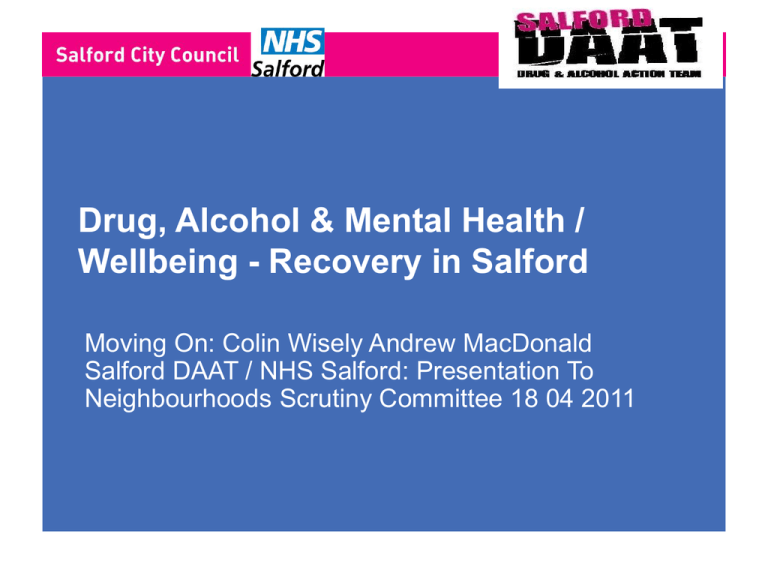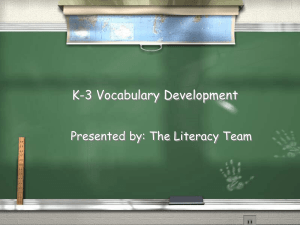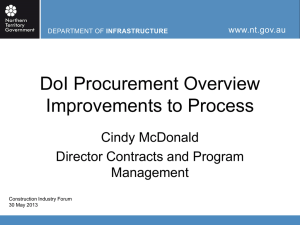Drug, alcohol and mental health wellbeing
advertisement

Drug, Alcohol & Mental Health / Wellbeing - Recovery in Salford Moving On: Colin Wisely Andrew MacDonald Salford DAAT / NHS Salford: Presentation To Neighbourhoods Scrutiny Committee 18 04 2011 National Drug & Alcohol Strategy Strategy 2 overarching aims: • • Reduce illicit and other harmful drug use Increase the numbers recovering from their dependence Strategy 3 main themes: • • • Reducing demand Restricting supply Building recovery in communities Healthy Living Problem Drug / Alcohol use Recovery Tier ‘0’ Community Activity E.g. self-help Tier 1 Generic Community Drug & Alcohol Services e.g. GPs Tier 2 Semi Structured Community Drug and Alcohol Services Tier 3 Structured Case Management Community Drug and Alcohol Services Tier 4 Residential Drug & Alcohol Services – Detoxification/Rehabilitation Recovery Path Tier 1 Recovery Path Tier 2 Recovery Path Tier 3 Recovery Path Tier 4 Current Models of Care Drug and Alcohol ‘Tiered’ Treatment System Features • Some drug and alcohol users of all ages never enter formal treatment and ‘recover’ in the community (described as Tier ‘0’) - not all develop ‘problems’ – also where longer term ‘recovery’ takes place – very underdeveloped • Case Management / Care Coordination all age groups Tier 3 - acts as the ‘gatekeeper’ for complex / coordinated care – an important feature – but relatively poor at managing exit because that is not it’s function • Increasingly younger users and newer types do not identify as having a ‘problem’ – so require new services and new thinking on structures and governance • The lack of structure below Tier 3 means when cases closed recovery journey (highlighted in green) less coordinated encourages drop out / raises risk of relapse / overdose / exclusion / community safety et al National Issues – Challenge In Salford • Shift from acute care model • Keeping an ageing population of problematic drug users healthy • Emphasise completion of treatment • • Emphasise re-engagement of drop out of treatment Identifying problematic drug users ready for treatment and caring for those in recovery • Prevention interventions for younger drug users at risk of developing chronic drug and alcohol problems • Establishing family focused approaches • Identifying problematic drug use at an early stage Gaps In Current System • Changing patterns in drugs markets • Significant levels chronic alcoholism in drugs ‘treatment’ cohort • Needs of those that are leaving treatment • Children of problematic drug and alcohol users • Need to re-engage treatment drop-outs • Complex Alcohol, Drugs, Mental Health all levels and co-morbidity Issues Arising From New Schema • Increasingly older (average 40+ nationally but only 34 in Salford) • Higher levels mortality and comorbidity in ageing population of heroin and crack users • Declining incidence recorded younger heroin users • Continued growth in the mass market for cannabis and new and old stimulant drugs • Often combined with alcohol and tobacco • ‘Legal highs’ and cocaine use challenge for mainstream population • Cannabis and Stimulants present challenge mental health services • Future challenge concerns distinguishing early onset of chronic drug and alcohol problems and responding to mass normative use • This implies fine grain profiling of families and individuals Shift in Health Needs Using Population • Users present to adult services designed for opiate users • Adult services shifting towards recovery orientation – city remains over invested in Tier 3 prescribing modalities • Majority young people do not use drugs - those who do many in a brief and normative fashion • Challenge identifying young people early & distinguishing brief and normative phases of use from chronic patterns • Challenge communicating good quality drugs and alcohol messages to those using in a brief and normative fashion • Challenge to address the needs young people in families where adults are problematic drug and alcohol users Key Commissioning Messages • Numbers successful problem drug user amd non problem drug user treatment completions risen considerably since 2006 unplanned exits stable • Future financial allocations calculated - retained in treatment moderated by days ‘in-treatment’ • Considerable evidence base in terms of what works in recovery • Re-engaging / Retaining drop-outs crucial – services need to reduce relapse amongst completers Wholly-attributable alcohol-related hospital admissions and alcohol consumption in adults (litres per person per year) in England since 2002 (NHS IC 2010, IAS 2010) Alcohol Use In Salford • NDTMS 1: 14 harmful or dependent drinkers 18 + in treatment • NATMS 572 young people who are primary alcohol users in Salford • Further 155 young people alcohol misuse as an adjunctive problem to range primary substances Young People Drug and Alcohol Use • Most young people do not use drugs, including alcohol, and for most of those who do their use is brief and normative • First challenge is effective early intervention to distinguish brief and normative from chronic patterns of use • More serious challenge communicating harm reduction messages to brief and normative users and engaging with young people in families where adults are problematic drug & alcohol users Offenders – Hidden Alcohol Harm Pending Nice Guidance 2011 Future Drug and Alcohol Service Provision – Salford’s View of the National Strategy • New strategy emphasises outcomes drugs and alcohol abstinence ultimate goal – significantly shift • • • Current model highly invested in specialist clinical interventions and lacks prevention focus or an aftercare recovery approach Integrated co-commissioning approach future investment in recovery highlights drugs and alcohol to downsize Tier 3 services and increase throughput towards recovery • Tier 3 limited drug free outcomes stasis - drop out and re-engaging little progress wider treatment domains i.e. how well individuals function in community, family Implies an upscale of Tier 2 service to managing stable drug users post Tier 3 treatment – the same applies to alcohol users • Need to commission services for niche needs of service users and existing drug and alcohol services offer a more ‘one size fits all’ approach Future Drug and Alcohol Service Provision – Salford’s View of the National Strategy • Process of building a recovery community well underway and task is integrating and enhancing existing local efforts • Evidence base for this largely comes from the USA summarised by White and Kelly (2010) • Need for better provision for young people particularly the under 25s, which cross cuts the drugs, alcohol and young people strategies • Key shift involves early intervention in chronic drug and alcohol problems identifying future Problematic Drug Users and Problem Drinkers • Clear signal to re-design criminal justice drugs interventions to improve efficiencies and outcomes in relation to HMP through care and the ‘gripping’ of high crime causing drug and alcohol users • Overall, new design will emphasise integrated drug and alcohol provision which has the capacity to flex to individual need as appropriate NICE recommends Children’s and Adults’ commissioners jointly commission specialist services young people to age of 25 or 30 • Pattern and culture of drinking, and the social circumstances of this group, are often different to those of older adults • Children and young people less likely to have alcohol dependence than adults but hazardous drinking behaviours (binge-drinking) • Full NICE clinical guideline managing alcohol dependence highlights multi-systems, multilevel approach - integrated alcohol services for children and young people ‘One Size Fits All’ does not fit Salford Children, Young People, Adults and Families – Integrated Service required for all ‘levels’ of complexity in Salford • Level ‘0’ Recovery Community, Neighbourhood / Health Improvement Teams / Self Help / WWW based provision • Level ‘1’ Lifestyle / Wellbeing Gateway and Generic Services • Level ‘2’ Lifestyle / Wellbeing Gateway and Semi Structured Services, with External Care Coordination to manage those cases exiting structured treatment • Level ‘3’ Structured Services with Specialist External Care Coordination for Structured and Highly Structured Treatment and Interventions • Level ‘4’ Highly Structured Services including all Residential Detoxification and Rehabilitation across Recovery Provision Tiered Treatment 4 & Chronic Care 3 2 1 0 Prison Enters Treatment IBA CJS Crime Re-enters treatment Re-enters treatment Drop out Relapse Extended IBA / Group Detoxified 4 Sustained 3 Recovery 2 Relapse Child of Problem Drinker 1 Abstinent Recovery 0 4 3 2 1 0 Recovery RECOVERY GRIP TEAM CLUB Move on RECOVERY specific art,cooking, budgets UNIVERSAL: Breakfast club etc INTERVENTIONS Fitness,groups, FAMILY & CARER WELFARE & BUDGET ETE HOUSING RECOVERY CLUB Ideal Recovery Treatment System Under 25s Tier 1 universal advice and information harm reduction Tier 2 targeted groups counselling / IBA LAC/ SSD / SMART / school Tier 3 remodelled under 25s service to deflect joiners to adult system Tier 4 limited demand – some migrate to adult 17 years, some at 30 Transition Key fault line between Under 25s and Over 25s Determined by risk / need Therefore most over 18s Over 25s Changing drug markets Alcohol/Cocaine users (‘bounded’ and ‘unbounded’ poly-substance use) Improve assertive approaches Establish ‘chronic’ case management approach Establish improved aftercare Tier Integrated Drug & Alcohol Services Population Current £ Future £ 0 General Population of Early / Unmet / Recovery: communication / self awareness – knowledge – efficacy – help / Recovery Community Activity 125,200 (30,000 drug users) 60K ? 1 Prevention / Screening / Generic / Targeted Outreach / Brief Interventions 58,320 (10,000 drug users) 204K ? 2 Triage / Non Complex Care Coordination / Aftercare / Step Down / Needle Exchange / Harm Reduction / Extended Brief Interventions / Low Intensity IAPT / Housing / Acute / Criminal Justice / GP Services 49,680 (5,000 drug users) 940K ? 3 Complex Care Coordination / Gate keeping / Community Medical Services / Prescribing / Community Detoxification / High Intensity IAPT / Housing / Acute / Criminal Justice / GP Services 17,200 (2500 drug users) 4,151K ? 4 Complex and Non Complex Residential Detoxification and Rehabilitation 17,200 (2500 drug users 934K ? 125,200 Problem drug/alcohol users £6,129K £6,129K Total Timeline 2013 Integrated Services Tender Drugs and Alcohol Recovery System 2011 2012 2013 Agree new Recovery Specifications Tender new Recovery System Establish new Recovery Services Apr – June 2011 Move On Service at Gloucester House provides input into specification Jan – Mar 2012 Tender scoring, supplier KPIs and contract documentation Pre tender documentation Jan – Mar 2013 Transition period from ‘As-Is’ to ‘To-Be’ service Apr –June 2011 Initial draft of tender specification Apr – Oct 2012 Tender process, April 2013 New service model starts Apr – Sept 2011 Benchmarking with external suppliers Sept – Oct 2012 Contract discussions and tender award confirmed July – Sept 2011 Final draft of tender specification Nov – Dec 2012 Contingency period Sept – Dec 2011 Sign off of tender specification







